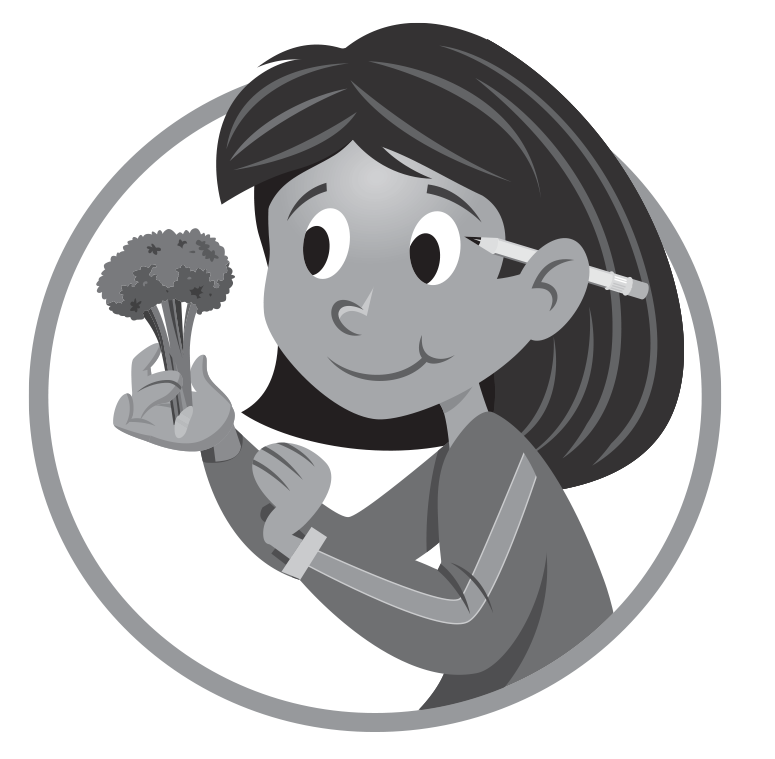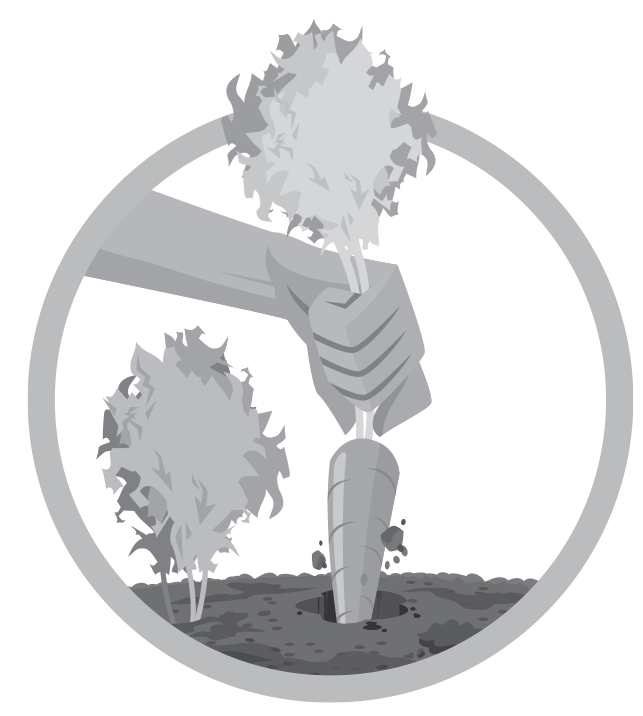Dig 'Em Up
Students investigate the functions of roots, recognize the difference between a tap and fibrous root system, and identify the roots of some plants as edible.
Background
Lesson Activities
Recommended Companion Resources
Credits
Author
Shaney Emerson and Michelle Risso | California Foundation for Agriculture in the Classroom
Acknowledgements
This lesson update was funded by a grant from the Network for a Healthy California.
Executive Director: Judy Culbertson
Illustrator: Erik Davison
Layout & Design: Nina Danner
Copy Editor: Leah Rosasco
Sources
- https://bonnieplants.com/library/the-importance-of-roots/
- http://www.businessinsider.com/10-crops-that-feed-the-world-2011-9?op=1
Standards
Texas Content Area Standards
-
ELA: K.110.2.b.1
Developing and sustaining foundational language skills: listening, speaking, discussion, and thinking - - oral language. The student develops oral language through listening, speaking, and discussion.
- ELA: K.110.2.b.1.D: work collaboratively with others by following agreed-upon rules for discussion, including taking turns;
-
ELA: 1.110.3.b.1
Developing and sustaining foundational language skills: listening, speaking, discussion, and thinking - - oral language. The student develops oral language through listening, speaking, and discussion.
- ELA: 1.110.3.b.1.D: work collaboratively with others by following agreed-upon rules for discussion, including listening to others, speaking when recognized, and making appropriate contributions
-
ELA: 2.110.4.b.1
Developing and sustaining foundational language skills: listening, speaking, discussion, and thinking -- oral language. The student develops oral language through listening, speaking, and discussion.
- ELA: 2.110.4.b.1.D: work collaboratively with others by following agreed-upon rules for discussion, including listening to others, speaking when recognized, making appropriate contributions, and building on the ideas of others
-
Math: 1.111.3.b.7
Geometry and measurement. The student applies mathematical process standards to select and use units to describe length and time.
- Math: 1.111.3.b.7.A: use measuring tools to measure the length of objects to reinforce the continuous nature of linear measurement
- Math: 1.111.3.b.7.D: describe a length to the nearest whole unit using a number and a unit
-
Math: 2.111.4.b.9
Geometry and measurement. The student applies mathematical process standards to select and use units to describe length, area, and time.
- Math: 2.111.4.b.9.D: determine the length of an object to the nearest marked unit using rulers, yardsticks, meter sticks, or measuring tapes
-
Social Studies: 1.113.12.c.9
Economics. The student understands the value of work. The student is expected to:
- Social Studies: 1.113.12.c.9.B: describe how various jobs contribute to the production of goods and services
-
Social Studies: 2.113.13.c.7
Economics. The student understands the roles of producers and consumers in the production of goods and services. The student is expected to:
- Social Studies: 2.113.13.c.7.C: trace the development of a product from a natural resource to a finished product
-
Social Studies: 2.113.13.c.16
Social studies skills. The student communicates in written, oral, and visual forms. The student is expected to:
- Social Studies: 2.113.13.c.16.E: communicate information visually, orally, or in writing based on knowledge and experiences in social studies
-
Social Studies: K.113.11.c.14
Social studies skills. The student communicates in oral and visual forms. The student is expected to:
- Social Studies: K.113.11.c.14.C: communicate information visually, orally, or in writing based on knowledge and experiences in social studies
- Social Studies: K.113.11.c.14.D: create and interpret visuals, including pictures and maps
-
Social Studies: 1.113.12.c.17
Social studies skills. The student communicates in oral, visual, and written forms. The student is expected to:
- Social Studies: 1.113.12.c.17.C: communicate information visually, orally, or in writing based on knowledge and experiences in social studies
- Social Studies: 1.113.12.c.17.D: create and interpret visual and written material
-
Science: 2.112.4.b.1
Scientific and engineering practices. The student asks questions, identifies problems, and plans and safely conducts classroom, laboratory, and field investigations to answer questions, explain phenomena, or design solutions using appropriate tools and models. The student is expected to:
- Science: 2.112.4.b.1.A: ask questions and define problems based on observations or information from text, phenomena, models, or investigations
- Science: 2.112.4.b.1.D: use tools, including hand lenses, goggles, heat-resistant gloves, trays, cups, bowls, beakers, notebooks, stream tables, soil, sand, gravel, flowering plants, student thermometer, demonstration thermometer, rain gauge, flashlights, ramps, balls, spinning tops, drums, tuning forks, sandpaper, wax paper, items that are flexible, non-flexible items, magnets, hot plate, aluminum foil, Sun-Moon-Earth model, and frog and butterfly life cycle models to observe, measure, test, and compare
- Science: 2.112.4.b.1.E: collect observations and measurements as evidence
- Science: 2.112.4.b.1.F: record and organize data using pictures, numbers, words, symbols, and simple graphs
- Science: 2.112.4.b.1.G: develop and use models to represent phenomena, objects, and processes or design a prototype for a solution to a problem
-
Science: K.112.2.b.1
Scientific and engineering practices. The student asks questions, identifies problems, and plans and safely conducts classroom, laboratory, and field investigations to answer questions, explain phenomena, or design solutions using appropriate tools and models. The student is expected to:
- Science: K.112.2.b.1.A: ask questions and define problems based on observations or information from text, phenomena, models, or investigations.
- Science: K.112.2.b.1.D: use tools, including hand lenses, goggles, trays, cups, bowls, sieves or sifters, notebooks, terrariums, aquariums, samples (rocks, sand, soil, loam, gravel, clay, seeds, and plants), windsock, demonstration thermometer, rain gauge, straws, ribbons, non-standard measuring items, blocks or cubes, tuning fork, various flashlights, small paper cups, items that roll, noise makers, hot plate, opaque objects, transparent objects, foil pie pans, foil muffin cups, wax paper, Sun-Moon-Earth model, and plant life cycle model to observe, measure, test, and compare.
- Science: K.112.2.b.1.E: collect observations and measurements as evidence.
- Science: K.112.2.b.1.F: record and organize data using pictures, numbers, words, symbols, and simple graphs.
- Science: K.112.2.b.1.G: develop and use models to represent phenomena, objects, and processes or design a prototype for a solution to a problem.
-
Science: K.112.2.b.2
Scientific and engineering practices. The student analyzes and interprets data to derive meaning, identify features and patterns, and discover relationships or correlations to develop evidence-based arguments or evaluate designs. The student is expected to:
- Science: K.112.2.b.2.B: analyze data by identifying significant features and patterns.
- Science: K.112.2.b.2.C: use mathematical concepts to compare two objects with common attributes.
- Science: K.112.2.b.2.D: evaluate a design or object using criteria to determine if it works as intended.
-
Science: K.112.2.b.3
Scientific and engineering practices. The student develops evidence-based explanations and communicates findings, conclusions, and proposed solutions. The student is expected to:
- Science: K.112.2.b.3.A: develop explanations and propose solutions supported by data and models.
- Science: K.112.2.b.3.B: communicate explanations and solutions individually and collaboratively in a variety of settings and formats.
- Science: K.112.2.b.3.C: listen actively to others' explanations to identify important evidence and engage respectfully in scientific discussion.
-
Science: K.112.2.b.5
Recurring themes and concepts. The student uses recurring themes and concepts to make connections across disciplines. The student is expected to:
- Science: K.112.2.b.5.A: identify and use patterns to describe phenomena or design solutions.
- Science: K.112.2.b.5.F: describe the relationship between the structure and function of objects, organisms, and systems.
- Science: K.112.2.b.5.G: describe how factors or conditions can cause objects, organisms, and systems to either change or stay the same.
-
Science: K.112.2.b.12
Organisms and environments. The student knows that plants and animals depend on the environment to meet their basic needs for survival. The student is expected to:
- Science: K.112.2.b.12.A: observe and identify the dependence of plants on air, sunlight, water, nutrients in the soil, and space to grow.
-
Science: K.112.2.b.13
Organisms and environments. The student knows that organisms resemble their parents and have structures and undergo processes that help them interact and survive within their environments. The student is expected to:
- Science: K.112.2.b.13.A: identify the structures of plants, including roots, stems, leaves, flowers, and fruits.
-
Science: 1.112.3.b.1
Scientific and engineering practices. The student asks questions, identifies problems, and plans and safely conducts classroom, laboratory, and field investigations to answer questions, explain phenomena, or design solutions using appropriate tools and models. The student is expected to:
- Science: 1.112.3.b.1.A: ask questions and define problems based on observations or information from text, phenomena, models, or investigations.
- Science: 1.112.3.b.1.D: use tools, including hand lenses, goggles, heat-resistant gloves, trays, cups, bowls, beakers, sieves/sifters, tweezers, primary balance, notebooks, terrariums, aquariums, stream tables, soil samples (loam, sand, gravel, rocks, and clay), seeds, plants, windsock, pinwheel, student thermometer, demonstration thermometer, rain gauge, straws, ribbons, non-standard measuring items, flashlights, sandpaper, wax paper, items that are magnetic, non-magnetic items, a variety of magnets, hot plate, aluminum foil, Sun-Moon-Earth model, and plant and animal life cycle models to observe, measure, test, and compare.
- Science: 1.112.3.b.1.E: collect observations and measurements as evidence.
- Science: 1.112.3.b.1.F: record and organize data using pictures, numbers, words, symbols, and simple graphs.
- Science: 1.112.3.b.1.G: develop and use models to represent phenomena, objects, and processes or design a prototype for a solution to a problem.
-
Science: 1.112.3.b.2
Scientific and engineering practices. The student analyzes and interprets data to derive meaning, identify features and patterns, and discover relationships or correlations to develop evidence-based arguments or evaluate designs. The student is expected to:
- Science: 1.112.3.b.2.B: analyze data by identifying significant features and patterns.
- Science: 1.112.3.b.2.C: use mathematical concepts to compare two objects with common attributes.
- Science: 1.112.3.b.2.D: evaluate a design or object using criteria to determine if it works as intended.
-
Science: 1.112.3.b.3
Scientific and engineering practices. The student develops evidence-based explanations and communicates findings, conclusions, and proposed solutions. The student is expected to:
- Science: 1.112.3.b.3.A: develop explanations and propose solutions supported by data and models.
- Science: 1.112.3.b.3.B: communicate explanations and solutions individually and collaboratively in a variety of settings and formats.
- Science: 1.112.3.b.3.C: listen actively to others' explanations to identify important evidence and engage respectfully in scientific discussion.
-
Science: 1.112.3.b.5
Recurring themes and concepts. The student uses recurring themes and concepts to make connections across disciplines. The student is expected to:
- Science: 1.112.3.b.5.A: identify and use patterns to describe phenomena or design solutions.
- Science: 1.112.3.b.5.F: describe the relationship between the structure and function of objects, organisms, and systems.
- Science: 1.112.3.b.5.G: describe how factors or conditions can cause objects, organisms, and systems to either change or stay the same.
-
Science: 2.112.4.b.2
Scientific and engineering practices. The student analyzes and interprets data to derive meaning, identify features and patterns, and discover relationships or correlations to develop evidence-based arguments or evaluate designs. The student is expected to:
- Science: 2.112.4.b.2.B: analyze data by identifying significant features and patterns
- Science: 2.112.4.b.2.C: use mathematical concepts to compare two objects with common attributes
- Science: 2.112.4.b.2.D: evaluate a design or object using criteria to determine if it works as intended
-
Science: 2.112.4.b.3
Scientific and engineering practices. The student develops evidence-based explanations and communicates findings, conclusions, and proposed solutions. The student is expected to:
- Science: 2.112.4.b.3.A: develop explanations and propose solutions supported by data and models
- Science: 2.112.4.b.3.B: communicate explanations and solutions individually and collaboratively in a variety of settings and formats
- Science: 2.112.4.b.3.C: listen actively to others' explanations to identify important evidence and engage respectfully in scientific discussion
-
Science: 2.112.4.b.5
Recurring themes and concepts. The student uses recurring themes and concepts to make connections across disciplines. The student is expected to:
- Science: 2.112.4.b.5.A: identify and use patterns to describe phenomena or design solutions
- Science: 2.112.4.b.5.F: describe the relationship between the structure and function of objects, organisms, and systems
- Science: 2.112.4.b.5.G: describe how factors or conditions can cause objects, organisms, and systems to either change or stay the same
-
Science: 2.112.4.b.13
Organisms and environments. The student knows that organisms have structures and undergo processes that help them interact and survive within their environments. The student is expected to:
- Science: 2.112.4.b.13.A: identify the roots, stems, leaves, flowers, fruits, and seeds of plants and compare how those structures help different plants meet their basic needs for survival

